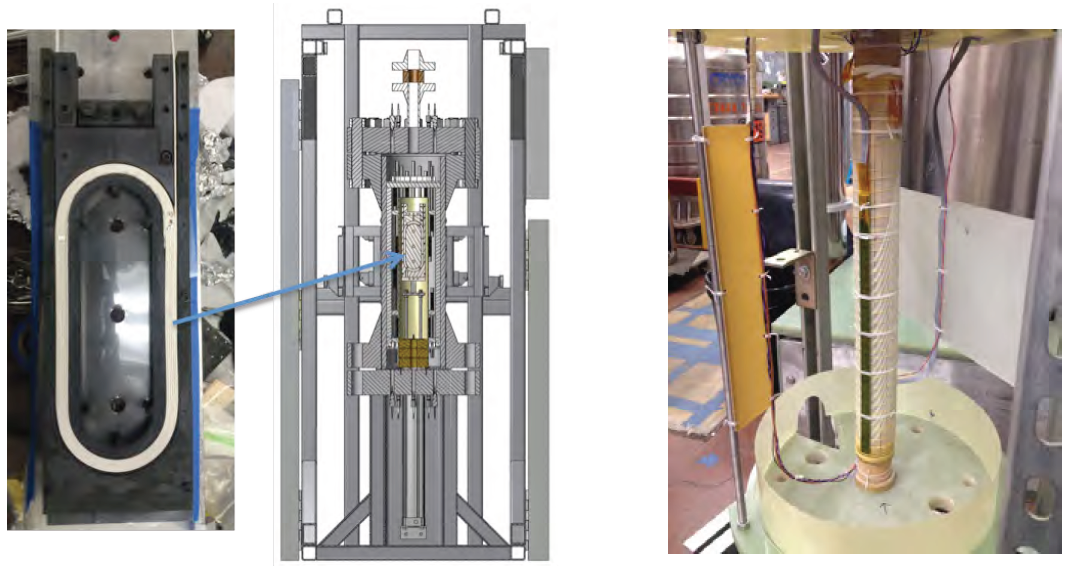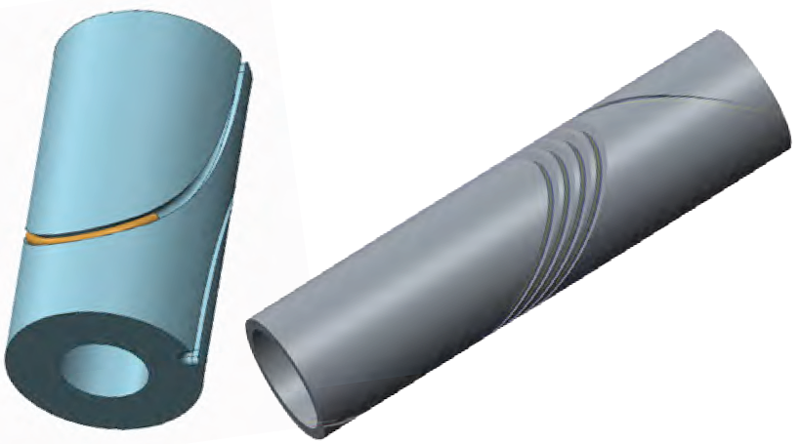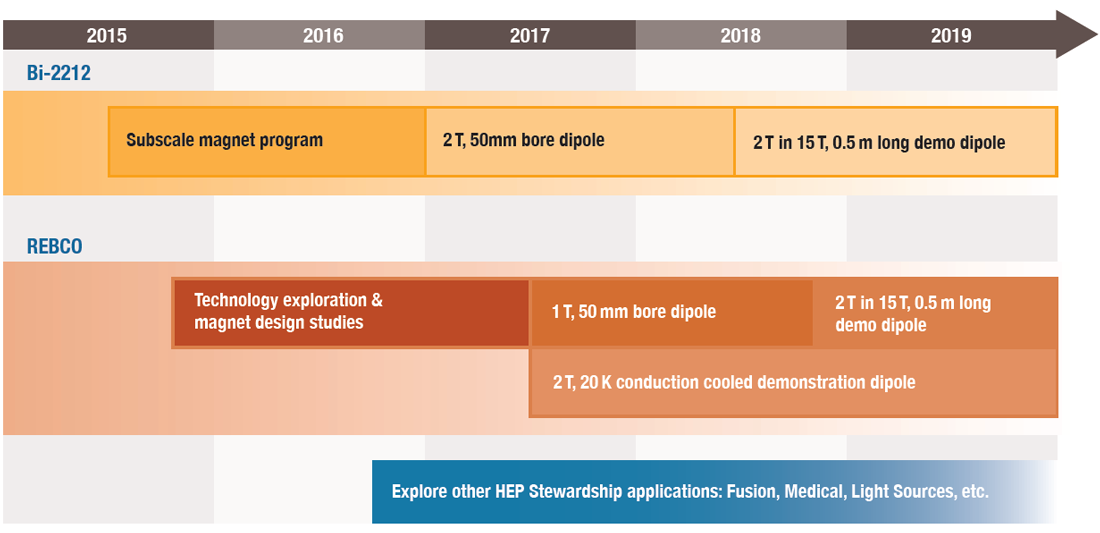This element of the program will develop magnets with high-temperature-superconductor (HTS) inserts to achieve fields beyond those attainable with Nb3Sn alone, as well as HTS stand-alone magnets for special applications.
The HTS program is primarily focused on determining the feasibility of these materials for use in accelerator magnets, but will take a broad, generic approach to development of the technology. The overarching goal is to design and fabricate HTS accelerator magnets that generate record field while maintaining an ongoing vigorous science program, using a full suite of design, fabrication, test and instrumentation tools available from the participating institutions.
 Click for larger version Above, left: LBNL Bi-2212 racetrack coils in Florida State University furnace. Above, right: Bi-2212 Canted-Cosine-Theta coil in test fixture. |
We will study and develop both Bi-2212 and Rare Earth-Barium-Copper Oxide (REBCO) materials and related technologies, working with Small Business Innovation Research/industry and DOE university programs. HEP MDP goals for HTS magnet development will focus on unique capabilities, goals and driving questions relevant to HEP. However, we note that there are areas of strong overlap with other DOE Office of Science programs where development of enabling technology could be leveraged through collaboration and coordination with other research efforts, particularly university programs. One example would be high current (10 kA-class) cables that are of mutual interest for HEP and Fusion applications. |
|
Bi-2212 sub-scale magnets using racetrack and CCT configurations to demonstrate HTS dipole technology
The approach is to use the previously developed racetrack magnet R&D platform1 and the new CCT geometry to explore technology limits to 5 T or greater in a dipole configuration for both stand-alone magnets and high-field inserts with bores greater than or equal to 50 mm and lengths ranging from 50 – 100 cm.
The near term focus is on developing the basic magnet technology capable of leveraging recent gains in current density stemming from overpressure processing:2 this includes further development and optimization of insulation and structural materials compatible with the ~900° C oxygen environment, better understanding of the impact of conductor strain on transport current, and optimization of magnet design to eliminate conductor damage at field.3
These efforts will be followed by detailed subscale magnet tests on quench detection and propagation, a critical issue with HTS magnets; the experiments will be performed in parallel with quench modeling, leading to the design and optimization of magnet protection schemes for Bi-2212 magnets.
REBCO-based dipole and quadrupole magnets using racetrack and CCT coil configurations with the best available cable designs.
Initial examples include stacked tapes and Conductor on Round Core (CORC).4
The approach includes the design and test of CCT dipole magnets using CORC and stacked-tapes and quadrupole magnets made using racetrack coils. Near-term plans include: systematic evaluation of the cable designs, including current redistribution in the cable during magnet ramping; development of coil fabrication processes, including cable insulation, coil winding, and vacuum impregnation; study of quench behavior, including normal zone growth, dynamic temperature rise, and resulting thermally induced strain; and analysis and measurement of magnetization and development of mitigation measures.
 Click for larger version |
Left: YBCO (yttrium barium copper oxide) stacked tape test mandrel. Right: CORC (conductor on round core) conductor test mandrel. |
 Click for larger version |
||
For both HTS options we will leverage recent developments in sensitive quench detection schemes and fast extraction circuits based on insulated-gate bipolar transistors (IGBTs) to facilitate magnet protection schemes. From that basis, we will develop magnet protection models to design and optimize protection techniques for hybrid LTS-HTS magnets, i.e., HTS inserts in larger-bore low-temperature-superconductor (LTS) dipoles. Note that the current LTS CCT dipole designs already incorporate 90 mm bores compatible with future HTS insert testing.
Both of these programs will be used as technology development testbeds to guide US conductor development with leverage from the SBIR and DOE Conductor R&D programs.
HTS development path and milestones
Progress on the activities generally described here will be monitored via well-defined milestones over the next two years to establish viability of these materials for a broad range of potential magnet applications.

Overview of the HTS milestone plan, highlighting the Bi-2212 magnet development (top) and the REBCO magnet development (bottom).
Meet the team leads

Xiaoring Wang, LBNL |

Tengming Shen, LBNL |
||
References
1 A. Godeke, D.W. Cheng, D.R. Dietderich, C.R. Hannaford, S.O. Prestemon, G. Sabbi, X.R. Wang, Y. Hikichi, J. Nishioka, and T. Hasegawa, “Progress in Wind-and-React Bi-2212 Accelerator Magnet Technology,” IEEE Transactions on Applied Superconductivity 19, 3 (2009), pp. 2228–2231.
2 D.C. Larbalestier, J. Jiang, U. P. Trociewitz, F. Kametani, C. Scheuerlein, M. Dalban-Canassy, M. Matras, P. Chen, N.C. Craig, P. J. Lee, and E. E. Hellstrom, “Isotropic Round-Wire Multifilament Cuprate Super-Conductor for Generation of Magnetic Fields Above 30 T,” Nature Materials 13, 4 (9 March 2014), pp. 375-381.
3 L. Ye, P. Li, T. Shen, J. Schwartz, “Quench Degradation Limit of Multifilamentary Ag/ Bi2Sr2CaCu2Ox Round Wires,” Superconductor Science and Technology 29, 3 (2 February 2016) 035010.
4 D.C. van der Laan, “YBa2Cu3O7-δ Coated Conductor Cabling for Low AC-Loss and High-Field Magnet Applications,” Superconductor Science and Technology 22, 6 (28 April 2009), 065013.
